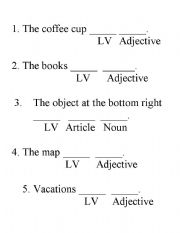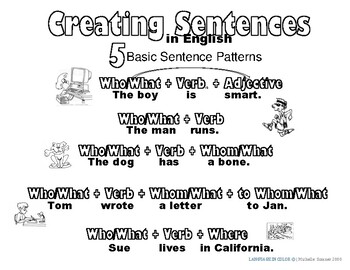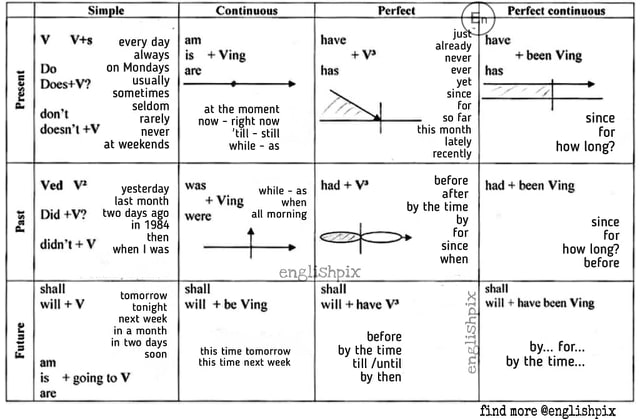Basic Sentence Patterns We do not speak English by merely stringing words together in some random fashion. Instead, we arrange our words, for the most part unconsciously, into patterns. In English we use nine basic sentence patterns. It will now be our purpose to examine these basic sentence patterns of English. Sentence combining: Sentence structures Combine each set of simple sentences below to produce the kind of sentence specified in parentheses. You will have to add, delete, change, and rearrange words. Recycling takes time. It reduces garbage in landfills. People begin to recycle. They generate much less trash. This study is aimed at the analysis of basic sentence patterns in. Sentence Pattern One: Subject-Verb (S-V) The most basic sentence pattern consists of a subject and a verb. The verb may be an action verb or a linking verb. Look at the following examples: Example: James W. Example: He began to build homes after World War II. Example: Walter offered to build affordable housing. For more on osentence grammar, see English Fundamentals by Emery, Kierzek, and Lindblom (Macmillan) for a thorough discussion of sentence grammar, along with exercises. Basic sentence patterns. Subject + verb. The simplest of sentence patterns is composed of a subject and verb without a direct object.
Related Topics:More Lessons on English Grammar
IELTS, TOEFL and English as a Second Language
In these lessons, we will learn the different ways of introducing the subject in a declarative sentence, basic sentence patterns and the types of sentence patterns.
The following diagram gives some examples of sentence patterns. Scroll down the page for more examples of sentence patterns.
Declarative Sentence Pattern
A sentence must express a complete thought. It must also have both a subject and a predicate. It is possible to express a complete thought in a variety of ways.
Normal Order
There are a number of ways of introducing the subject in a declarative sentence. The normal order is subject first followed by the predicate. If we always followed this pattern, our sentences would soon become monotonous and uninteresting. This is illustrated by the following paragraph.
Example:

My friend gave me a book. It is a book about dogs. I enjoyed reading the book.
In the above paragraph, all the sentences follow the same pattern – subject first, followed by the predicate. We can give more variety to our sentence pattern by placing the words in different positions.
Inverted Order
We can put the subject after the verb or place it at the end of the sentence. This would be called inverted order.
Example:

In my bag, I found an interesting book about dogs. (The subject I is placed after the group of words: In my bag)
Down the street marched the band. (The subject band appears at the end of the sentence)
Interrogative Sentence Pattern
The interrogative sentence is generally in inverted order. Sometimes the interrogative sentence starts with a verb. Often it begins with an adverb, which is used to answer the question.
Example:
Did you bring your books? (Starts with the verb did)
Where did you buy this shirt? (Starts with the adverb where)
Imperative and Exclamatory Sentence Patterns
In the imperative or exclamatory sentence, the subject is seldom expressed. If the subject is not expressed, the word you is implied.
Example:
Open the door now! (The subject you is implied)
Please read the announcements. (The subject you is implied)
Sentences that begins with 'There'
When the word there is used to introduce the sentence, it is possible to place the subject after the verb.
Example:
There was a heavy rainfall last night.
When the word there is used to introduce a sentence, it is called an expletive. The word expletive comes from Latin and it means ‘added merely to fill up’. The word there merely fills up the space normally occupied by the subject.
Basic English Grammar: Order In Sentences
Have you ever wondered what makes some writing more interesting than other writing? Good writers vary the order in sentences.
Basic Sentence Patterns
Subject + VerbExample:
Melissa reads.
She is eating.
Subject + Verb + Object
Example:
I like eggs.
She sees her sister.
Subject + Verb + Adjective
Example:
Laura is busy.
He is smart.
Subject + Verb + Adverb
Example:
Sarah is here.
Jack ran slowly.
Subject + Verb + Noun
Example:
She is my friend.
They are teachers.
- Show Step-by-step Explanations
Types of Sentence Patterns
We will now look at 5 patterns in the English language.Pattern 1 - Subject + Verb
Example:
 Pauly waltzed onto the dancefloor.
Pauly waltzed onto the dancefloor.She read.
The tired old woman cleaned often.
Pattern 2 - Subject + Verb + Direct Object
Example:
Pauly bought a new dress.
She read the book.
The old woman cleaned the drapes.
Pattern 3 - Subject + Verb + Direct Object + Indirect Object
Example:
Pauly bought her sister a new dress.

The old woman gave the pharmacy her prescription.
Pattern 4 - Subject + Linking Verb + Noun Complement
Example:
Melissa was the class president.
The boys were boy scouts.
Pattern 5 - Subject + Linking Verb + Adjective Complement
Example:
The house is very old.
I am very hungry.
Try the free Mathway calculator and problem solver below to practice various math topics. Try the given examples, or type in your own problem and check your answer with the step-by-step explanations.
We welcome your feedback, comments and questions about this site or page. Please submit your feedback or enquiries via our Feedback page.

All the parts of speech in English are used to make sentences. All sentences include two parts: the subject and the verb (this is also known as the predicate). The subject is the person or thing that does something or that is described in the sentence. The verb is the action the person or thing takes or the description of the person or thing. If a sentence doesn’t have a subject and a verb, it is not a complete sentence (e.g., In the sentence “Went to bed,” we don’t know who went to bed). Here’s your quick introduction to the basic English sentence structure.
Simple, compound, and complex sentence structures
There are three types of sentences: simple, compound, and complex. The type of sentence is determined by how many clauses, or subject–verb groups, are included in the sentence. A simple sentence structure has one independent clause: “I rode my bike.” A compound sentence has at least two independent clauses: “I got in my car, and I drove into town.” In that sentence, both clauses can stand on their own as complete sentences. A complex sentence includes an independent clause and one or more dependent clauses: “I got in my car and then went to town.” In that sentence, “I got in my car” works as a complete sentence but “then went to town” does not.
Most sentences in English are constructed using one of the following five patterns:
- Subject–Verb
- Subject–Verb–Object
- Subject–Verb–Adjective
- Subject–Verb–Adverb
- Subject–Verb–Noun
The subject is the person or thing taking an action or being described in the sentence. The verb is the action the subject takes.
Subject–Verb
This type of sentence begins with a core sentence such as “Jane walks.” Here, “Jane” is the subject and “walks” is the verb. Different parts of speech can be added to expand the sentence.
You can add an adverb to make the sentence “Jane walks quickly,” or you can add an expression of time to tell when she walks, e.g., “Jane walks all morning.”
Subject–Verb–Object
These sentences begin with a core sentence such as “She is playing a piano.” In this sentence, “She” is the subject, “is playing” is the verb, and “a piano” is the object.
You can add elements to expand the sentence, such as an adjective (e.g., “She is playing a small piano”) or an adverb (e.g., “She is playing the piano beautifully”).
Subject–Verb–Adjective
This type of sentence begins with a core sentence like “He is handsome.” Here, “he” is the subject, “is” is the verb, and “handsome” is the adjective.
Like the other types of sentences, you can expand on the sentence by adding other parts of speech, such as “He is very handsome,” where “very” serves as an adverb.
Subject–Verb–Adverb
These sentences begin with a core sentence such as “The girl walked away.” In this sentence, “the girl” is the subject, “walked” is the verb, and “away” is the adverb.
You can add elements to this type of sentence, such as “The girl slowly walked away,” where “slowly” is an adjective describing how the girl walked.
Subject–Verb–Noun
Basic Sentence Patterns In English Pdf Converter
Sentences of this type begin with a core sentence such as “The professor is a woman.” Here, “the professor” is the subject, “is” is the verb, and “a woman” is the noun. As with the other sentence types, you can add words or phrases to expand on the sentence. For example, you can add the adjective “intelligent” and the adverbial phrase “at the university” to say “The professor at the university is an intelligent woman” to describe the professor more and tell where where she works.
Basic Sentence Patterns Pdf
Now that you know how to form sentences in English – based on your new knowledge of the basic English sentence structure, check out our article on Basic English punctuation to learn how to properly punctuate them.
Bonus info: style guides for media are a great way to learn about clear and consise writing – a good place to start is the BBC News style guide.
Basic Sentence Patterns In English Pdf
Read more
Resources
